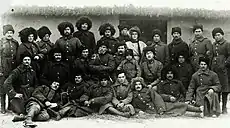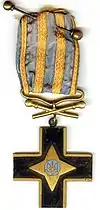First Winter Campaign
The First Winter Campaign (Ukrainian: Перший Зимовий Похід; 6 December 1919 — 6 May 1920). Was a campaign by the Ukrainian People's Republic against the Bolsheviks in Ukraine during the Soviet-Ukrainian War. The main task of the Winter Campaign was to maintain the presence of the Ukrainian People's Army (UPA) in Ukrainian territory against the enemies, through guerrilla action. At the end of November 1919, the remnants of the Ukrainian forces were surrounded (Lyubar-Chortoria-Myropil). The Ukrainian Galician Army, due to Petliura's agreement with the Second Polish Republic, was forced to join General Anton Denikin's Russian Volunteer Army after 6 November 1919. The Ukrainian People's Army troops were surrounded by three enemy armies — the Red Army, Russian Volunteer Army and Polish Army (with which reconciliation was achieved at that time); in addition, Ukrainian units suffered from the typhus epidemic. On 6 December 1919, at a military meeting in Nova Chortoria, it was finally decided to carry out a Winter Campaign by units of the UPR and the rear of the Volunteer Army. About 5,000 Ukrainians and 35,000–60,000 Poles took part in the campaign against the Red and Volunteer Armies.[5] However, the composition of the Ukrainian combat-ready units numbered 2,000 bayonets, 1,000 sabers and 14 guns.
| First Winter Campaign | |||||||
|---|---|---|---|---|---|---|---|
| Part of the Soviet–Ukrainian War | |||||||
 Ukrainian fighters before the start of the military winter campaign, December 1919 | |||||||
| |||||||
| Belligerents | |||||||
|
|
| ||||||
| Commanders and leaders | |||||||
|
|
| ||||||
| Strength | |||||||
|
|
| ||||||
| Casualties and losses | |||||||
|
681 Ukrainians killed[1] 10,000 Poles killed and wounded[2] |
35,000 Russians killed and wounded[3] 32,000 Bolsheviks killed and wounded[4] | ||||||
Background
The First World War saw tremendous upheaval in Ukraine, and in the short period between the spring of 1917 and late of 1919, three governments had taken shape in the capital, Kyiv. However, the political situation was difficult because of the international pressure from Poland, and especially the Bolsheviks.
By late 1919, it became clear that conventional warfare against the Bolshevik forces in Ukraine had become impossible, so the Ukrainian People's Republic had decided to demobilize its military and conduct partisan warfare behind Bolshevik lines.[6]
Participating Units
There were three main Ukrainian units - they were renamed divisions in February 1920. Group "Zaporizhzhia" was commanded by the Ukrainian General Andriy Huliy-Hulenko; Group “Kyiv" was commanded by the Ukrainian General Yuriy Tyutyunnyk; and Group "Volhynia" was commanded by the Ukrainian General Oleksander Zahrodsky.[6][7] The chief of staff during the campaign was Andriy Dolud.[8]
Main Battles

During the entire campaign, around 2,500 kilometers were covered by the enemy, more than 50 battles Ukrainians has successfully won.
Because of the nature of the campaign, the armies covered much territory. Originally the main theater of war was the Yelizavhrad Oblast, but as the Bolshevik-Denikin front moved south, so did the campaign.
The route of the First Winter Campaign passed through the territories of the present Zhytomyr (Romaniv, Lyubar, Chudniv districts), Kyiv (Tetiïv district), Cherkasy (almost all districts), Kirovohrad (almost all districts), Mykolaiv (Vradiyiv, Domaniv, Voznesensk, Novobuhsky, Kazan districts), Odesa (Mykolaiv, Lyubashivsky, Ananiyevsky, Baltic districts), Vinnytsia (in 1919 - Khmelnytsky, Kalynivsky, Kozyatynsky, Lipovetsky, Pohrebyschensky, Orativsky, the end of the campaign - Chechelnytsky, Bershadsky, Trostya, Tomashpilsky, Yampilsky, Tulchinsky, Pishchansky districts).
The main battles of the First Winter Campaign took place at Lypovets, Zhashkiv, Uman, Kaniv, Cherkasy, Smila, Zolotonosha, Olviopol, Holovanivsk, Haisyn, Voznesensk, Ananiv, and Balta.[6]
Aftermath
According to military historians, the First Winter Campaign of the Ukrainian People’s Republic forces is a significant page in the period of the Ukrainian Revolution (1917–1921). For the first time, the Ukrainian Army successfully used guerrilla methods to fight numerous enemies. All returning Winter Campaign participants were awarded the Order of the Iron Cross of the Ukrainian People's Republic.[9] The Ukrainian troops were able to fulfill their goals and liberated many Ukrainian territories, including the capital of Ukraine — Kyiv together with Poland in the Kyiv offensive (1920) against the Bolsheviks.
See also
References
- Wayback Machine. Anatoliy Buravchenkov, “First Winter Campaign of the Ukrainian Army 1919–1920”. 7 August 2016.
- Petro Zlenko, “Winter Campaign. Bibliography“. 31 October 2020.
- Roman Koval, “Guerrilla Raid of the Ukrainian Army (First Winter Campaign)”. Kyiv, “Diokor”, 2001.
- likbez.org.ua. Andriy Matskiv, “6 December in our military history”. 8 December 2017.
- "Ukrainian Intelligence Officer Ivan Lytvynenko". SZRU. 2019-01-25. Retrieved 2020-06-21.
- Encyclopedia of Ukraine
- "Yu.Tyutyunnyk in Ukrainian rebel movement and Mykolaivschyna". SZRU. 2015-10-16. Retrieved 2020-06-21.
-
- Gutsal P . Dolud Andriy // Ternopil encyclopedic dictionary : in 4 volumes / editor: G. Yavorsky and others. - Ternopil: Publishing and Printing Plant "Zbruch" , 2004. - Vol. 1: A - J. - P. 519. - ISBN 966-528-197-6.
- "UKRAINE IRON CROSS UNR FOR 1ST WINTER CAMPAIGN 1917-21 LAST JUBILEE ISSUE RRR". eBay. Retrieved 2020-06-21.